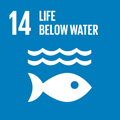- Docente: Nicholas Fantuzzi
- Credits: 6
- SSD: ICAR/08
- Language: English
- Teaching Mode: In-person learning (entirely or partially)
- Campus: Ravenna
-
Corso:
Second cycle degree programme (LM) in
Offshore Engineering (cod. 9249)
Also valid for Campus of Bologna
Second cycle degree programme (LM) in Civil Engineering (cod. 8895)
Campus of Bologna
Second cycle degree programme (LM) in Chemical and Process Engineering (cod. 8896)
Learning outcomes
In the course, element for modelling ofoffshore structures will be given. Three main parts of the course will be: equivalent static and dynamic modelling of the actions, including wave action and wind, both in the time and frequency domains; finite element modelling of the structure, stress and displacement recovery and verifications; modelling and verifications against cyclic loadings, with special emphasis to fatigue and damage of metallic materials.
Course contents
Requirements/Prior knowledge
Fluent spoken English is a necessary pre-requisite: all lectures and tutorials, and all study material will be in English.
Course Contents
1. Introduction to structural solutions in the offshore environment
1.1 Platform typologies
1.2 Moorings
1.3 Pipelines
2. Environmental actions on offshore structures
2.1 Buoyancy and gravity
2.2 Fluid-induced structural forces (waves, currents and winds)
2.3 Earthquakes, ice impact and wave slamming
2.4 Deterministic and statistical descriptions of offshore waves
3. Dynamics of offshore Structures
3.1 Deterministic responses for single degree of freedom structures in time and frequency domain
3.2 Statistical responses for single degree of freedom structures
3.3 Responses of multi-degree of freedom linear structures
4. Finite Element Modelling of a fixed-bottom platform
4.1 Members, joints and mass modelling
4.2 Actions modelling (permanent loads, wind, waves and currents, soil-structure interaction)
4.3 Types of Analyses (static and quasi-static linear analysis, natural frequency, dynamically responding structures, non-linear analysis)
5. Fatigue assessment of offshore structures
5.1 Fatigue strength based on S-N curves
5.2 Damage accumulation rule and fatigue safety checks
5.3 Deterministic, simplified and spectral fatigue assessment methods
5.4 Stress concentration factor determination
5.5 Fracture mechanics approach
Readings/Bibliography
- Lecture slides and notes
- James F. Wilson, Dynamics of Offshore Structures, John Wiley & Sons, lnc., 2nd Edition, 2003. ISBN: 978-0471264675
- P.H. Wirsching, T.L. Paez, K. Ortiz, Random Vibrations. Theory and practice, Dover, 2005. ISBN: 0-486-45015-5
- A.J.M. Ferreira, N. Fantuzzi, MATLAB codes for finite element analysis, Springer, 2nd Edition, 2020. ISBN: 978-3-030-47951-0
- Inge Lotsberg, Fatigue Design of Marine Structures, Cambridge University Press, 2016. ISBN: 978-1107121331
- Guide for fatigue assessment of offshore structures, American Bureau of Shipping, 2003. Available at: https://ww2.eagle.org/content/dam/eagle/rules-and-guides/current/offshore/115_fatigueassessmentofoffshorestructures/Fatigue_Guide_e-Mar18.pdf
During lectures, some reading assignments will be made from selected papers in the published literature.
Teaching methods
The course content will be entirely covered by the lectures. The course includes some laboratory sessions, which will cover the practical aspects of the lectures. The instructors will tutor the students.
Assessment methods
A final written test is planned, based on questions intended to assess the knowledge and understanding of the topics covered by the course. Furthermore, the student should present the solutions of homework assignments.
The assessment of the "expected learning outcomes" is composed of:
- Presentation of homework assignments (compulsory to access the final test).
- Test composed of 10 questions (3 points each, up to 30 points).
- Oral discussion
To obtain a passing grade (minimum is 18 points**) students are required to demonstrate a knowledge of the key concepts of the subject, some ability for critical application, and a comprehensible use of technical language. Higher grades (maximum is 30 points, with honors) will be awarded to students who demonstrate an organic understanding of the subject, a high ability for critical application, and a clear and concise presentation of the contents.
** in case of failure students can take any next final term, generally there are 6 final terms per academic year.
Teaching tools
The teaching tools are overhead projector, projector and PC.
iPad will be used as whiteboard support tool for extra material details given to students at the end of each class.
The course includes some laboratory sessions in which examples and problems are solved and analyzed.
Office hours
See the website of Nicholas Fantuzzi
SDGs



This teaching activity contributes to the achievement of the Sustainable Development Goals of the UN 2030 Agenda.
